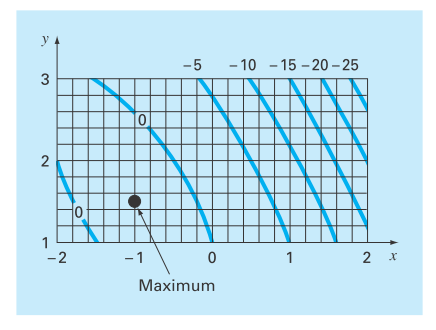
The grid search is another brute force approach to optimization. The two-dimensional version is depicted in Fig. P14.10. The x and y dimensions are divided into increments to create a grid. The function is then evaluated at each node of the grid. The denser the grid, the more likely it would be to locate the optimum.
Develop a program using a programming or macro language to implement the grid search method. Design the program so that it is expressly designed to locate a maximum. Test it with the same problem as Example 14.1.

FIGURE P14.10
The grid search.
Want to see the full answer?
Check out a sample textbook solution
Chapter 14 Solutions
EBK NUMERICAL METHODS FOR ENGINEERS
Additional Engineering Textbook Solutions
Fundamentals of Differential Equations (9th Edition)
Advanced Engineering Mathematics
Basic Technical Mathematics
Statistical Reasoning for Everyday Life (5th Edition)
Differential Equations: An Introduction to Modern Methods and Applications
- DETAILS CHAPMANML6 1.CQ.008. MY NOTES ASK YOUR TEACHER Complete the following sentence. Instead of typing commands directly in the Command Window, a series of commands can be placed into a file, and the entire file can be executed by typing its name in the Command Window. Such files are called files.arrow_forwardPlease make the same graph on MATLAB, I need help on making the exact copy of the graph that is shown on the picture. Please make it 100 percent accurate. Send the code. I need help.arrow_forwardB/ As shown in the following Fuzzy Sets = {Negative, Zero, Positive} Assuming that we are using trapezoidal membership functions, What is the degree of membership of x in each of the Fuzzy Sets at Crisp Input: x = 0.2 and -0.2? NEGATIVE ZERO POSITIVE 0.0 -3.0 -2.5 -1.0 -0.5 0.0 0.5 1.0 25 3.0arrow_forward
- 1) Model the following problem with integer programming. The marketing department has been allocated a budget of $10M and would like to determine which products to develop advertising campaigns; note: at most one campaign can be launched for each product. Their goal is to maximize revenue for the company. Data is presented in the table below. Product A BCD E F 10 7 12 8 6 Projected Revenue ($M) Cost ($M) 6 1 2 5 4 3arrow_forwardA manufacturing company produces two types of products called X and Y. Each product uses four different machines like lathe, drilling, grinding & milling operations. The profit per unit of selling X and Y are 7 RO and 3 RO respectively. Formulate a linear programming model with the given constraints to determine the production volume of each product in order to maximize the total profit (in OR). Solve the following linear programming model by using Graphical method. Subject to, 6X + 4Y < 24 X + 2Y < 6 -X + Y< 1 Y< 2 and X,Y 2 0arrow_forwardPlease answer with The Network Simplex Methodarrow_forward
- Please help, this for Matlab the image is the first question with following 2 and 3 they go together. 2. Solving the question by using bisection.m with the stopping criterion at 1%. Report the root and # of iterations. 3. by using newton-Raphson matlab script with the stopping criterion at 0.1%. Report the root and # of iterations.arrow_forwardSolve the last highlight by red pen experession only In which they said to draw a grapharrow_forwardWhich of the following is not part of the transportation algorithm Select one: a. balanced transportation table b. stepping-stone method c.portfolio selection. d. northwest corner rulearrow_forward
- DISCUSSION Before posting to the discussion board, complete the following: The concept of a weak solution of a boundary value problem plays an important role in some numerical solutions including the finite element method. The idea of a "weak solution" can be a rather weak notion. The following problem was presented in lecture 3 of week 8. It is generally not solvable in closed form. 00 on 0arrow_forwardmathforadmi..2dff1dd723 PTU Kadoorie sygini 1930 Technical Department of Applied Mathematics Second Semester 2020/2021 Math for Administration Assignment 2 Question 1 For the function: y = 0.01x- 0.001x² Find the zeros, the vertex and the optimum value (max. or min.) Question 2 Suppose a company has fixed costs of $300 and variable 3 costs of x + 1460 dollars per unit, 4 where x is the total number of units produced. Suppose further that the selling price of its product is 1500 X- ♡ lar Fine break-even points. init. II جامعة Palestine ||arrow_forward8. What are the main stages of the FEM? 9. Make a sketch of a linear triangular finite element. Point the nodes and write the approximating polynomial. 10. Describe with one sentence what the shape functions in FEM are. 11. Special case of which method is the method of Galerkin? 12. What are the three main parts of a FEM program? 13. How can be increased the accuracy of the derivatives for linear finite elements in FEM postprocessor? 14. Specify three methods for force computation in FEM postprocessor.arrow_forwardarrow_back_iosSEE MORE QUESTIONSarrow_forward_ios
 Elements Of ElectromagneticsMechanical EngineeringISBN:9780190698614Author:Sadiku, Matthew N. O.Publisher:Oxford University Press
Elements Of ElectromagneticsMechanical EngineeringISBN:9780190698614Author:Sadiku, Matthew N. O.Publisher:Oxford University Press Mechanics of Materials (10th Edition)Mechanical EngineeringISBN:9780134319650Author:Russell C. HibbelerPublisher:PEARSON
Mechanics of Materials (10th Edition)Mechanical EngineeringISBN:9780134319650Author:Russell C. HibbelerPublisher:PEARSON Thermodynamics: An Engineering ApproachMechanical EngineeringISBN:9781259822674Author:Yunus A. Cengel Dr., Michael A. BolesPublisher:McGraw-Hill Education
Thermodynamics: An Engineering ApproachMechanical EngineeringISBN:9781259822674Author:Yunus A. Cengel Dr., Michael A. BolesPublisher:McGraw-Hill Education Control Systems EngineeringMechanical EngineeringISBN:9781118170519Author:Norman S. NisePublisher:WILEY
Control Systems EngineeringMechanical EngineeringISBN:9781118170519Author:Norman S. NisePublisher:WILEY Mechanics of Materials (MindTap Course List)Mechanical EngineeringISBN:9781337093347Author:Barry J. Goodno, James M. GerePublisher:Cengage Learning
Mechanics of Materials (MindTap Course List)Mechanical EngineeringISBN:9781337093347Author:Barry J. Goodno, James M. GerePublisher:Cengage Learning Engineering Mechanics: StaticsMechanical EngineeringISBN:9781118807330Author:James L. Meriam, L. G. Kraige, J. N. BoltonPublisher:WILEY
Engineering Mechanics: StaticsMechanical EngineeringISBN:9781118807330Author:James L. Meriam, L. G. Kraige, J. N. BoltonPublisher:WILEY





